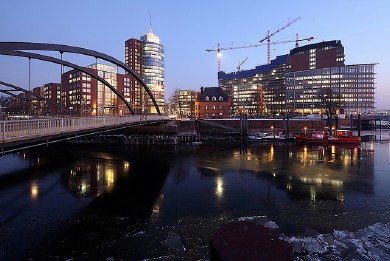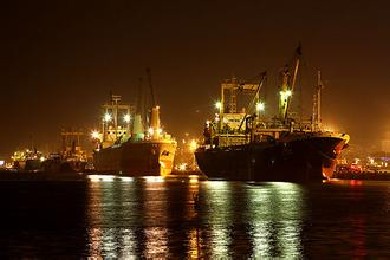A portainer (also known as a container crane, container handling gantry crane, quay crane, ship-to-shore crane or a STS crane) is a large dockside crane in the form of a specialized type of gantry crane used to load and unload container ships, and only seen at container terminals. The term Portainer is a registered trademark of Paceco Corp. who is generally believed to have delivered the first Container Crane to a marine terminal in Alameda, CA in the 1960s. Container cranes have a special lifting device called a spreader bar (also known as Spreader or Expandable Spreader) for loading and discharging of containers. The spreader bar has four or eight (twin-lift) twist locks which lock and unlock into the corner castings of the containers and can be used in 20', 40', or 45' positions depending on the size of the containers. Horizontal gantry rails[1] and their supporting structure are cantilevered out from between frame uprights spaced to suit the length of a standard freight container, so that the gantry rails project over a quayside and over the width of an adjacent ship allowing the hoist to lift containers from the quay and move out along the gantry rails on its trolley to place the containers on the ship. The whole crane runs on two rails so that it can traverse along the wharf (or the dock) to position the containers at any point on the length of the ship.
There are two common types of container handling gantry crane: high profiles (luffing boom) where the boom is hinged at the waterside of the crane structure and lifted up in the air to clear the ships for navigation; the second type is the low profiles shuttle boom crane where the boom is shuttled/pulled towards and over the ship to allow the trolley to load and discharge containers.
Amongst the major designers and manufactures of these cranes are ZPMC, Noell, Kone, Kocks, IMPSA, Paceco], Hyundai and Samsung.
Container Cranes are generally classified by their lifting capacity, and the size of the container ships they can load and unload containers. A Panamax crane can fully load and unload containers from a container ship capable of passing through the Panama Canal. A Post-Panamax crane can fully load and unload containers from a container ship too large to pass through the Panama Canal. The largest modern container cranes are classified as Super-PostPanamax. A modern container crane capable of lifting two 20 foot long containers at one time will generally have a rated lifting capacity of 65 long tons from under the Spreader. Post-Panamax cranes weigh approximately 800-900 long tons while the newer generation Super-PostPanamax cranes can weigh 1600-2000 long tons.
The crane is driven by an operator that sits in a cabin suspend from the trolley. The trolley runs along rails that are located on top or sides of the boom and girder. The operator runs the trolley over the ship to lift the cargo which generally are containers. Once the spreader latches (locks) on to the container with the Spreader, the container is lifted and moved over the dock and placed (discharged) on a truck chassis (trailer) to then be taken to the storage yard. The crane will also lift containers from the chassis to store (load) them on to the ship.
The cranes are powered by two types of power source; diesel engine driven generators which are located on top of the crane or direct electric power from the dock. The most common is electric power from the dock (also known as shore power) in which case the electric source can be from 4,000 up to 12,000 volts.
Lorries and containerlifters, also known as straddle-carriers, can manoeuvre underneath the base of the portainer crane, and collect the 'boxes'. They are designed to allow rapid cargo operations between the dock and storage yard.








